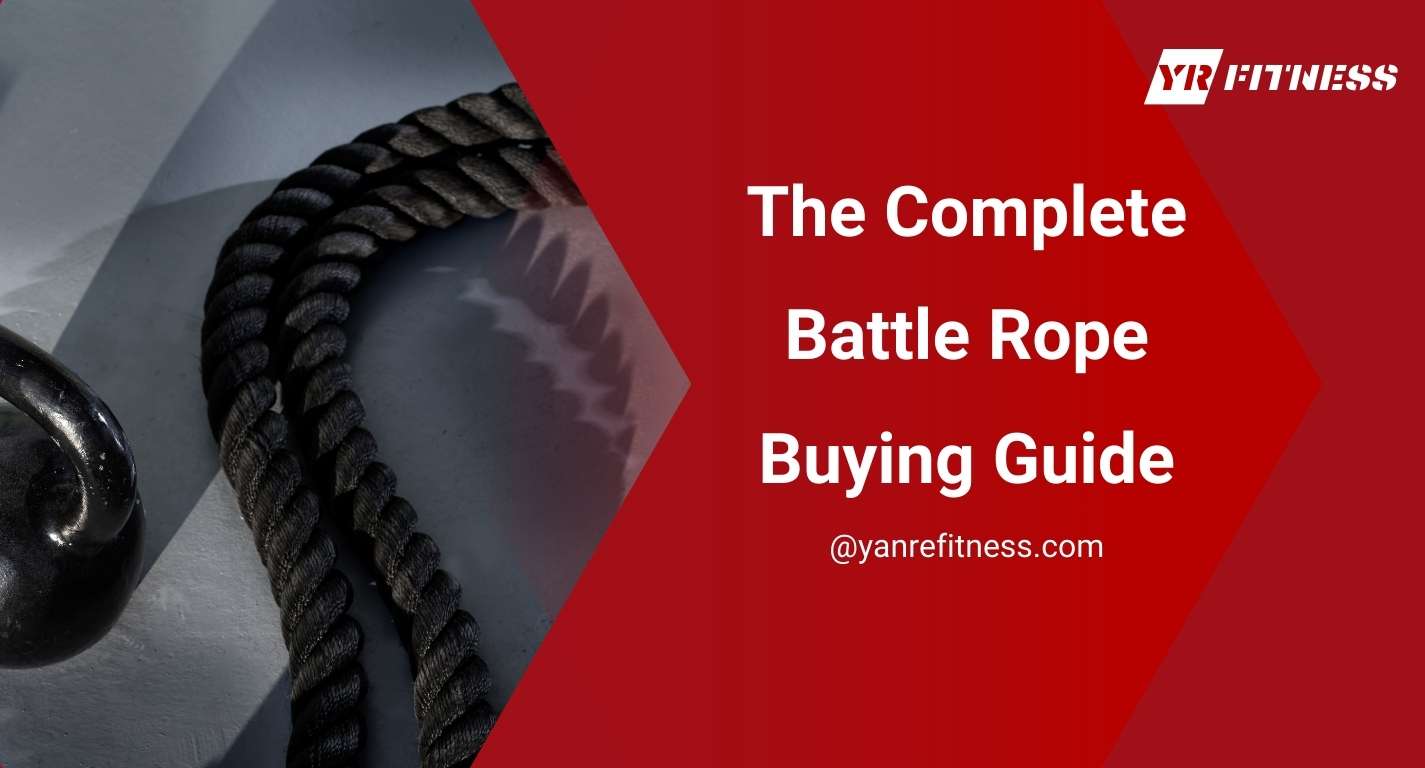Are you searching for the ideal battle ropes to elevate your gym’s training options? This guide will help you navigate the choices and find the right fit for your facility.
As a gym equipment expert, I know that choosing the perfect battle rope can be challenging. Understanding what sets each type apart can make all the difference when deciding on the best option for your gym.
Battle ropes are a versatile training tool that can cater to different fitness levels and goals. Selecting the right ones will enhance member experience, whether the focus is on endurance, strength, or conditioning.
In this guide, you’ll discover the key factors to consider, including rope types, physical properties, and buying tips, to help you make a well-informed decision.
So let’s dive in!
Table of Contents
1. Quick Comparison Chart
Understanding the differences between Poly Dacron and Manila battle ropes is crucial for gym owners looking to make an informed purchase. This chart highlights key distinctions between these 2 materials, covering aspects like durability, grip, and suitability for various training environments.
Feature | Poly Dacron | Manila |
Material Composition | Synthetic blend of polyester and polypropylene | Natural fibers from abaca plant |
Durability | High – Resistant to fraying and water | Moderate – Prone to wear and absorbs moisture |
Grip Texture | Smooth with anti-slip coatings | Rougher texture, offering a firm grip |
Weight | Lighter, ideal for speed training | Heavier, suitable for strength and power training |
Maintenance | Low – Easy to clean and maintain | High – Requires frequent maintenance |
Outdoor Use | Excellent – Resistant to weather conditions | Not ideal – Can degrade in harsh conditions |
Cost | Affordable | Generally more expensive |
Best For | Speed and endurance workouts | Power and strength workouts |
This comparison provides a clear view of how each material performs under different conditions, helping gym owners choose the best option based on their training focus and facility needs.
2. Battle Rope Physical Structure
The physical structure of a battle rope directly impacts its performance, lifespan, and comfort during workouts. Gym owners should evaluate the different components to ensure they are getting the most value for their investment. Here are the key elements to look at:
Rope
The rope itself is the core of the equipment and can be made from materials such as Poly Dacron or Manila. Poly Dacron ropes tend to have a smoother surface, while Manila ropes, on the other hand, offer a rougher texture, giving a stronger grip but are more likely to shed over time. Choosing the right rope material should depend on workout focus and environmental conditions.
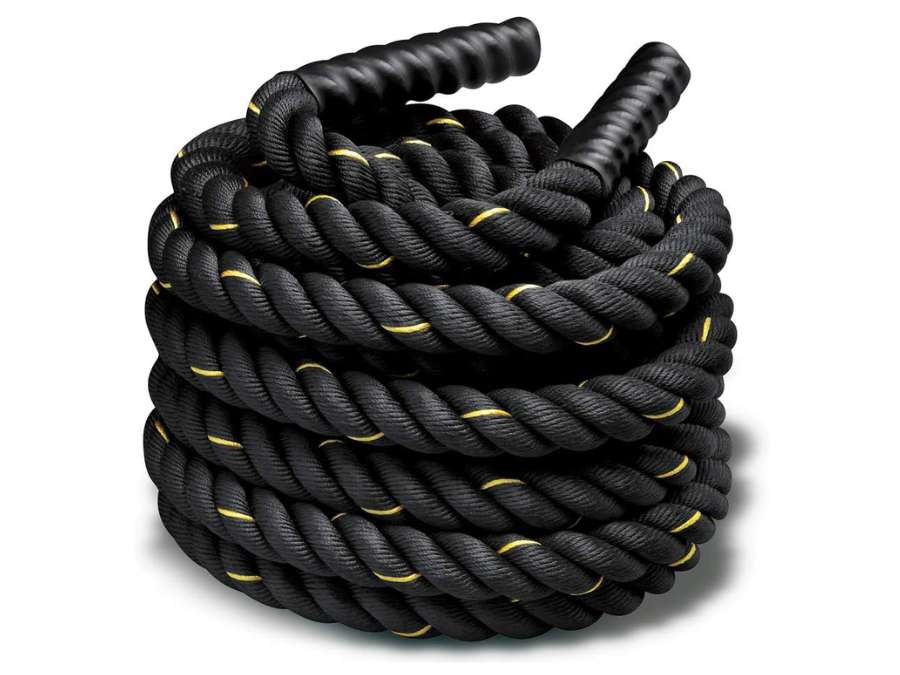
Handles
Handles are crucial for a comfortable grip and prevent the ends of the rope from fraying. Most battle ropes come with heat-shrink handles or rubberized coatings, providing a secure grip even during high-intensity training. Some variations also feature textured patterns that minimize slippage, which is beneficial for maintaining control during longer sets. A well-designed handle will keep the rope functional for a longer period.
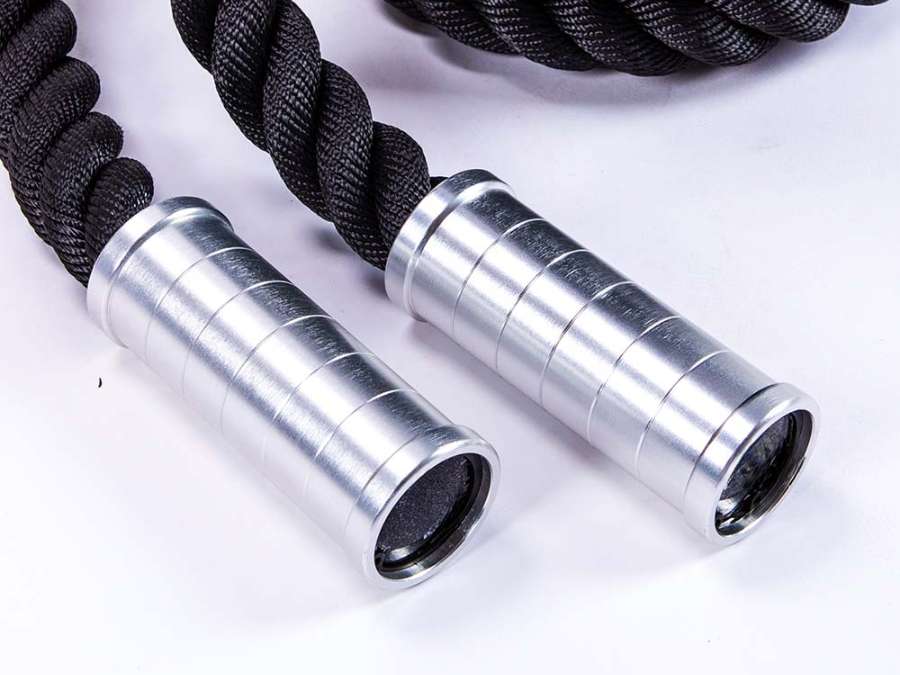
Protective Sleeves
Protective sleeves cover the main length of the rope, shielding it from friction and abrasion. This feature is particularly valuable if the rope will be used on rough surfaces like concrete or gravel. Some ropes come with full-length nylon sleeves, while others only have sections covered, which impacts durability. Choosing ropes with adequate coverage can significantly extend the rope’s lifespan, especially in high-traffic gym settings.
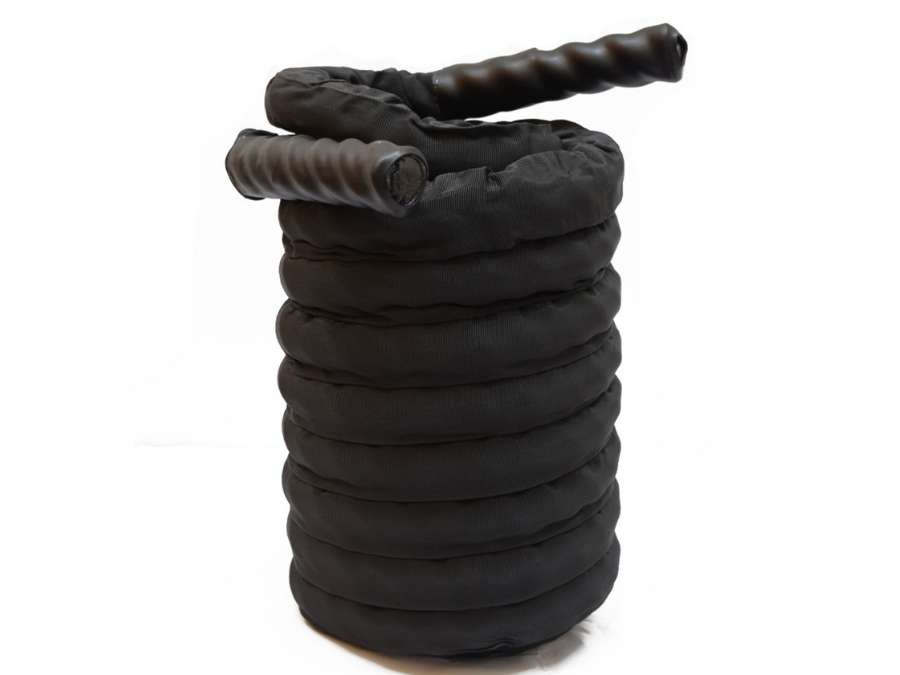
Anchor
An anchor is an attachment point that secures the rope during use, typically mounted on a wall or fixed to a heavy base. For instance, many ropes come with their own anchors, but high-quality options may require separate purchases for more specialized setups. YR Fitness recommends that selecting a stable anchor prevents unnecessary movement and maximizes the rope’s effectiveness during training.
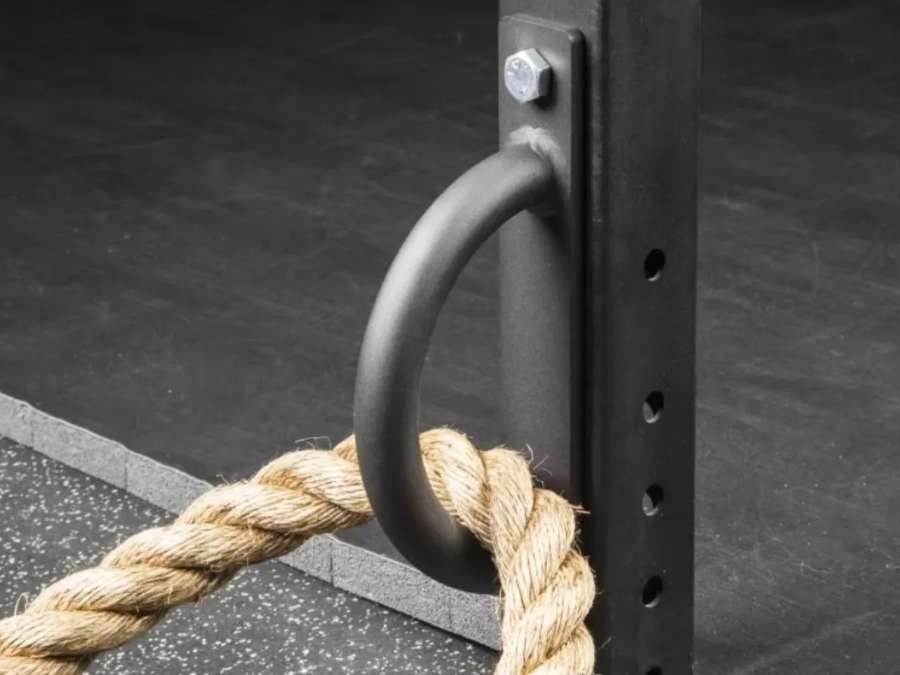
3. Battle Rope Types by Material
Choosing the right battle rope material is a key factor in determining its usability and longevity. Synthetic and natural battle ropes offer distinct characteristics, making them better suited for different training environments. Here are the main types to consider:
Synthetic Battle Rope: Poly Dacron
- Material Composition: Poly Dacron is a blend of polyester and polypropylene, making it highly resistant to wear and tear. This synthetic construction allows the rope to handle intense, repetitive use without significant fraying.
- Performance: These ropes are designed to handle various workout styles, from speed to endurance training. Similarly, the smoother surface minimizes friction, making it easier on the hands and perfect for extended use.
- Versatility: Poly Dacron is suitable for both indoor and outdoor settings, as it does not absorb moisture and is resistant to environmental factors.
- Maintenance: The synthetic nature of Poly Dacron means it requires minimal upkeep, retaining its shape and appearance over time. Gym owners can benefit from this low-maintenance option for busy facilities.
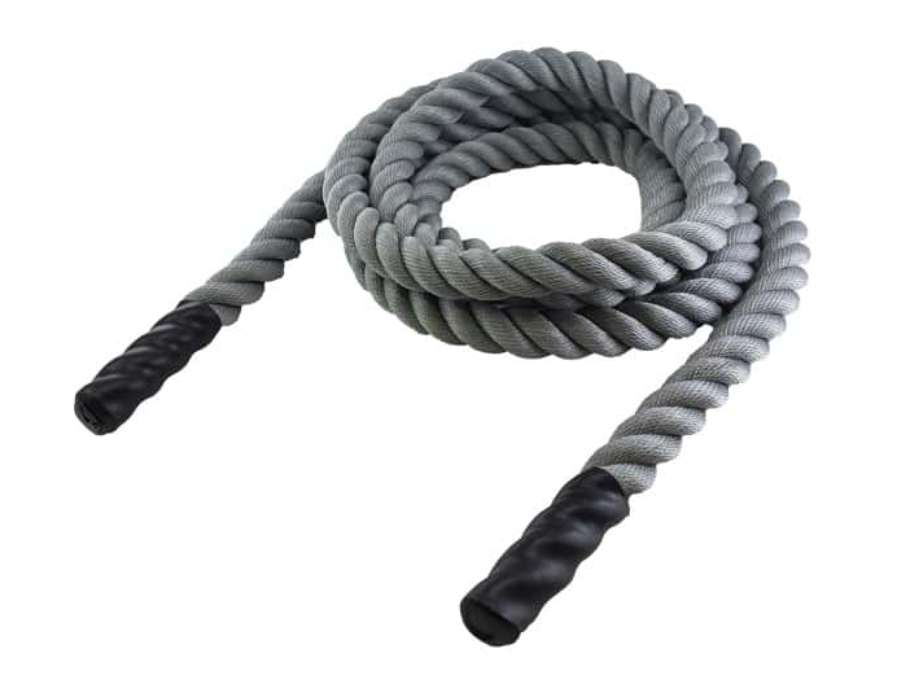
Natural Battle Rope: Manila
- Material Composition: Manila ropes are made from natural fibers of the abaca plant, giving them a rougher, textured feel. This provides a firmer grip, but it also means the rope can shed over time, especially with frequent use.
- Grip and Comfort: While the rough texture enhances grip, it can be tough on the hands, especially during longer workouts. Gym owners should consider this if catering to members who prefer gentler materials.
- Environmental Suitability: Manila ropes are best suited for indoor use as they tend to absorb moisture and degrade when exposed to harsh outdoor conditions.
- Maintenance Needs: These ropes require regular care to prevent mold and fiber breakdown. Investing in proper storage and routine checks will be necessary for maintaining the quality of Manila battle ropes.
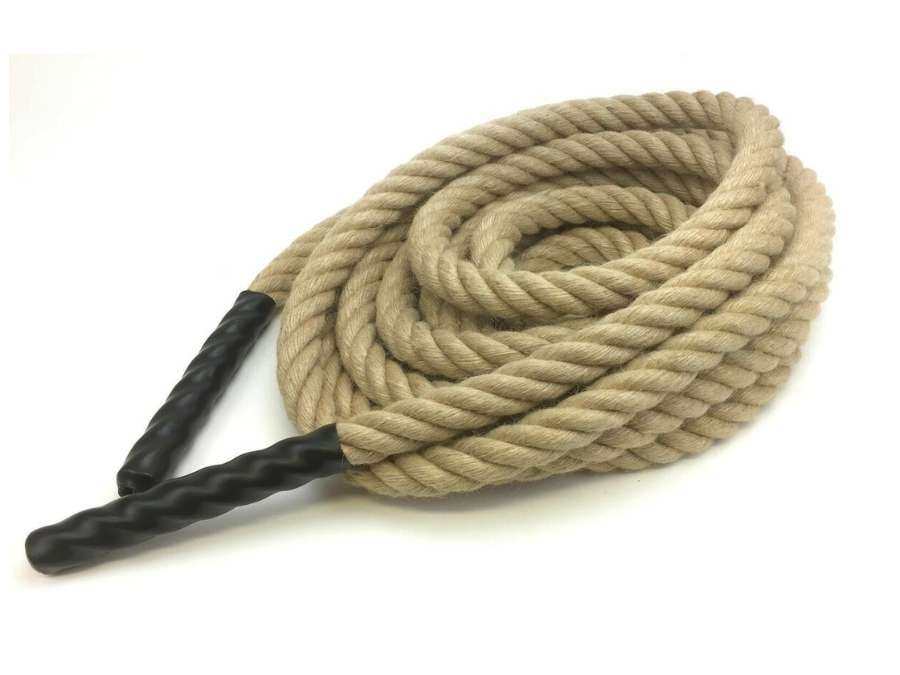
4. Battle Rope Physical Properties
Understanding the physical properties of battle ropes helps gym owners select the right options for their space and training goals. Here are the main properties to consider:
Size
Battle rope size affects both the intensity and versatility of the workouts offered in your gym. Understanding the relationship between size and workout goals is essential for maximizing the value of this versatile equipment. Here’s what to keep in mind:
Length
Battle ropes typically come in lengths of 30, 40, and 50 feet. Longer ropes create more resistance, making them ideal for advanced training and high-intensity workouts. Shorter lengths are better suited for beginners or gyms with limited space. Choosing the right length will depend on available space and the workout intensity level desired.
Thickness
Rope thickness typically ranges from 1.5 inches to 2 inches in diameter. Thicker ropes are heavier and provide more resistance, which is excellent for grip strength and upper body power. Conversely, thinner ropes are easier to handle and are a good fit for endurance-focused exercises. Selecting the appropriate thickness will enhance training effectiveness and member experience.
Weight
The weight of a battle rope is influenced by its length, diameter, and material. For instance, heavier ropes are better suited for power training as they offer higher resistance, while lighter ones are ideal for speed and endurance drills. Anyone will agree that when selecting a rope, it’s important to match the weight to the intended workout purpose.
Durability
Durability is a major factor to consider, especially in high-traffic gym environments. Poly Dacron ropes are known for their high resistance to abrasion and moisture, making them more suitable for long-term use. In contrast, Manila ropes can wear down faster, especially in humid or rough conditions, and may require more upkeep. Choosing a rope that can handle frequent, intense sessions will add value over time.
5. Battle Rope for Specific Training Goals
Selecting the right battle rope based on specific training goals will help maximize its effectiveness and meet the needs of your gym members. Here’s how to match battle ropes with different training objectives:
Power Training
Power training involves short, explosive movements that require heavier ropes for maximum resistance. Opt for 2-inch diameter ropes that are 50 feet long to provide greater weight and challenge grip strength. This combination is ideal for building upper body power and enhancing explosive force output. Gyms with members focused on powerlifting or high-intensity strength training will benefit from these options.
Endurance Training
For endurance workouts, lighter ropes with longer lengths are recommended. A 1.5-inch diameter rope that is 50 feet long works well for sustaining continuous movements over a longer period, promoting cardiovascular fitness and muscular stamina. This type is perfect for HIIT sessions or conditioning routines. Choosing ropes with less weight allows members to maintain speed and rhythm, making it suitable for high-repetition exercises.
Speed and Agility
Speed training requires ropes that are light and easy to maneuver. A 30- or 40-foot rope with a 1.5-inch diameter will provide minimal resistance, enabling fast and dynamic movements. These ropes are effective for enhancing quickness, coordination, and overall agility. Gyms focusing on athletic performance or functional training will benefit from these shorter, more responsive ropes.
6. 3 Buying Tips and Traps to Avoid
Selecting the right battle rope involves more than just looking at price or aesthetics. Avoiding common mistakes and understanding what truly matters can help gym owners make smarter purchases. Here are some tips and traps to watch out for:
- Space: Consider the space available in your gym when choosing battle ropes, as longer ropes (50 feet or more) need ample room. If space is tight, opt for shorter lengths (30 or 40 feet) to maintain workout quality without overcrowding the area.
- Handle Material: The handle material impacts both grip and durability. Look for heat-shrink or rubberized handles for a secure hold and added protection against wear and tear.
- Durability: Poly Dacron ropes offer higher durability and better resistance to moisture, making them ideal for frequent use. Manila ropes may degrade faster and need more maintenance, especially in humid environments.
- Slip Resistance: Handles with anti-slip coatings or textured patterns are essential for maintaining control during high-intensity workouts. This helps reduce the risk of accidents and improves grip stability, even with sweaty hands.
- Texture: Manila ropes provide a rough texture for a firmer grip, but can be tough on the hands during longer sessions. Poly Dacron ropes are smoother, offering comfort for extended use without compromising grip.
Conclusion
Understanding the various aspects of battle ropes is essential for gym owners looking to offer diverse and effective training options. Each type, whether synthetic or natural, has unique properties that cater to different workout styles and facility needs. Selecting the right battle rope can boost member satisfaction by providing a versatile tool for strength and endurance training.
If you are looking for durable and performance-driven battle ropes to upgrade your facility, YR Fitness specializes in providing high-quality commercial gym equipment. Our ropes are designed to meet the demands of professional training environments. Contact us today to find the perfect equipment for your gym’s needs.
Dive Deeper Into Our Resources
For some insightful reads, we’ve curated a list of recommended articles just for you:
Still haven’t found what you’re looking for? Don’t hesitate to contact us. We’re available around the clock to assist you.
Related articles:
